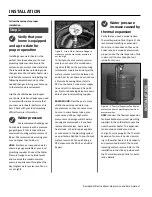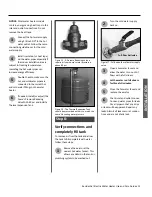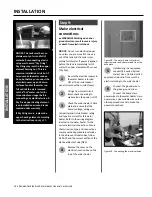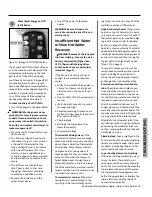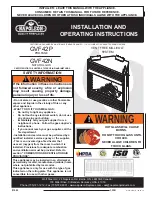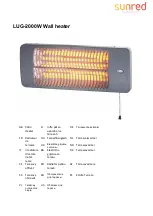
4 • Residen al Electric Water Heater Use and Care Guide
IMPORTANT SAFETY INFORMATION
T
o reduce the risk of property
damage, serious injury or death,
read and follow the precau ons below,
all labels on the water heater, and
the safety messages and instruc ons
throughout this manual.
RISKS DURING INSTALLATION
AND MAINTENANCE
Electric Shock Risk
Contact with the electrical
parts in the junction box and
behind the access doors can
result in severe injury or death from
electrical shock:
• Disconnect power by opening the
circuit breaker or removing the
fuses before installing or servicing.
• Use a non-contact circuit tester to
confirm that power is off before
working on or near any electrical
parts.
• Replace the junction box cover and
access doors after servicing.
Lifting Risk
WARNING!
The
water heater is
heavy. Follow these
precau ons to
reduce the risk of property damage,
injuries from li ing or impact injuries
from dropping the water heater.
• Use at least two people to lift the
water heater.
• Be sure you both have a good grip
before lifting.
• U se an appliance dolly or hand
truck to move the water heater.
RISKS DURING OPERATION
Scalding Risk
This water heater
can make water hot
enough to cause
severe burns instantly, resulting in
severe injury or death.
• Feel water before bathing or s how-
ering.
• To reduce the risk of scalding,
install Thermostatic Mixing Valves
(temperature limiting valves) at
each point-of-use. These valves
automatically mix hot and cold
water to limit the temperature at
the tap. Mixing valves are available
from your local plumbing supplier .
Follow manufacturer’s instructions
for installation and adjustment of
the valves.
• The thermostat(s) on this water
heater have been factory set to
approximately 120°F to reduce the
risk of scalding. Higher tempera-
tures increase the risk of scalding,
but even at 120°F, hot water can
scald. If you choose a higher tem-
perature, Thermostatic Mixing
Valves located at each point-of-use
are particularly important to help
avoid scalding.
Temperature Time to Produce a
Serious Burn
120°F (49°C)
More than 5 minutes
125°F (52°C)
1½ to 2 minutes
130°F (54°C)
About 30 seconds
135°F (57°C)
About 10 seconds
140°F (60°C)
Less than 5 seconds
145°F (63°C)
Less than 3 seconds
150°F (66°C)
About 1½ seconds
155°F (68°C)
About 1 second
For informa on about changing the
factory thermostat se ng(s), refer to
the “Adjus ng Temperature” sec on in
this manual (“Step 10” on page 15).
Even if you set the water heater
thermostat(s) to a low se ng, higher
temperatures may occur in certain
circumstances:
• In some cases, repeated small
draws of water can cause the
hot and cold water in the tank to
“stack” in layers. If this happens,
the water can be as much as thirty
degrees hotter than the thermo-
stat setting. This temperature varia-
tion is the result of your usage pat-
tern and is not a malfunction.
• Water temperature will be hot-
ter if someone adjusted the
thermostat(s) to a higher setting.
• Problems with the thermostat(s),
or other malfunctions may result in
higher than expected water tem-
peratures.
• If the water heater is in a hot envi-
ronment, the water in the tank can
become as hot as the surrounding
air, regardless of the thermostat
setting.
• If the water supplied to the water
heater is pre-heated (for example,
by a solar system) the temperature
in the tank may be higher than the
water heater’s thermostat setting.
To reduce the risk of unusually hot
water reaching the
fi
xtures in the
house, install Thermosta c Mixing
Valves at each point-of-use.
If anyone in your home is at par cular
risk of scalding (for example, the el-
derly, children, or people with disabili-
es) or if there is a local code or state
law requiring a certain water tempera-
ture at the hot water tap, then these
S
AFETY







